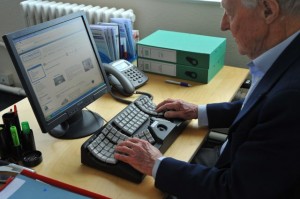What is the best hand position to prevent RSI?
A major cause of Repetitive Strain Injury (RSI) is the prolonged and repetitive hand movements involved in computer keyboard use. Given the amount of time spent by most people at their computer typing it is no wonder that RSI is an issue of great concern in the workplace. The Victorian WorkCover Chief Executive reported in recent years that soft tissue and muscle injuries such as RSI accounted for 62% of all WorkCover claims. See our earlier blog for more statistics regarding the prevalence of RSI.
The design of many keyboards tends to create or exacerbate the problem. Read on to find out about the best hand positions to prevent or help manage RSI, and what you need to do to ensure you minimise your chances of getting this painful and disabling condition.
The basic idea is that when typing, the hands should be in a neutral position. The neutral position for the hand is as if shaking hands. Typing with your wrists in any position other than the neutral position puts strain on the tendons and muscles of your hands, and increases your risk of RSI, or makes existing RSI worse.
When you type, your wrists should be in a neutral position. That means like this:


The Neutral Position

Ulnar Deviation

Radial Deviation

Dorsiflexion
Ergonomic keyboards make it easier to type with your hands in the optimal position. As well as splitting the keyboard in the middle to reduce ulnar and radial deviation, they allow for the front of the keyboard to be raised to avoid dorsiflexion.
The premier, most innovative, individually designed and fully ergonomic keyboard on the market is the Maltron Keyboard. The following features set this keyboard apart from any other:
- The design of this ergonomic keyboard fits the shape of hands and the different lengths of fingers to reduce movement and tension.
- Split design eliminates wrist twist and allows a central number cluster which can be used by right or left hand as preferred.
- Tilted keys and pads minimise palms downward movement (Pronation) to further reduce muscle tension.
- Straight vertical key columns eliminate tens of thousands of finger and wrist twists in a day’s work.
- Thumb keys for Space (plus E on Maltron layouts), Return, Delete, Backspace and Cursor keys reduce hand and arm movement. Versatile thumbs are used far more effectively.
- Two key groups for letters with a central number group keep wrists straight and strain free.
- Redefined thumb groups with double height key for spaces (left space is the E with the Maltron Letter layout) now also have double height keys for return and tab.
- The letter keys are angled inwards to match natural finger movements and the keys for the longer fingers are recessed further to reduce finger “cramping” and provide a more relaxed hand posture.
- Large palm pads give a comfortable resting and relaxing zone for hands and arms during “thinking time”, to encourage blood flow and recovery.
- Four separate layout (2 x PC and 2 x Apple) key code lookup tables return correct key codes for PC and Apple specific functions.
- The Maltron ergonomic keyboard is available in a variety of languages and layouts, including QWERTY, Dvorak & Maltron.
See the below picture of its designer, Stephen Hobday using a Maltron keyboard. Note the neutral position of his hands:
Don’t let your keyboard be the cause of pain and potential loss of capacity. For more information about this innovative keyboard, and to order one, please contact us today.

Recent Comments